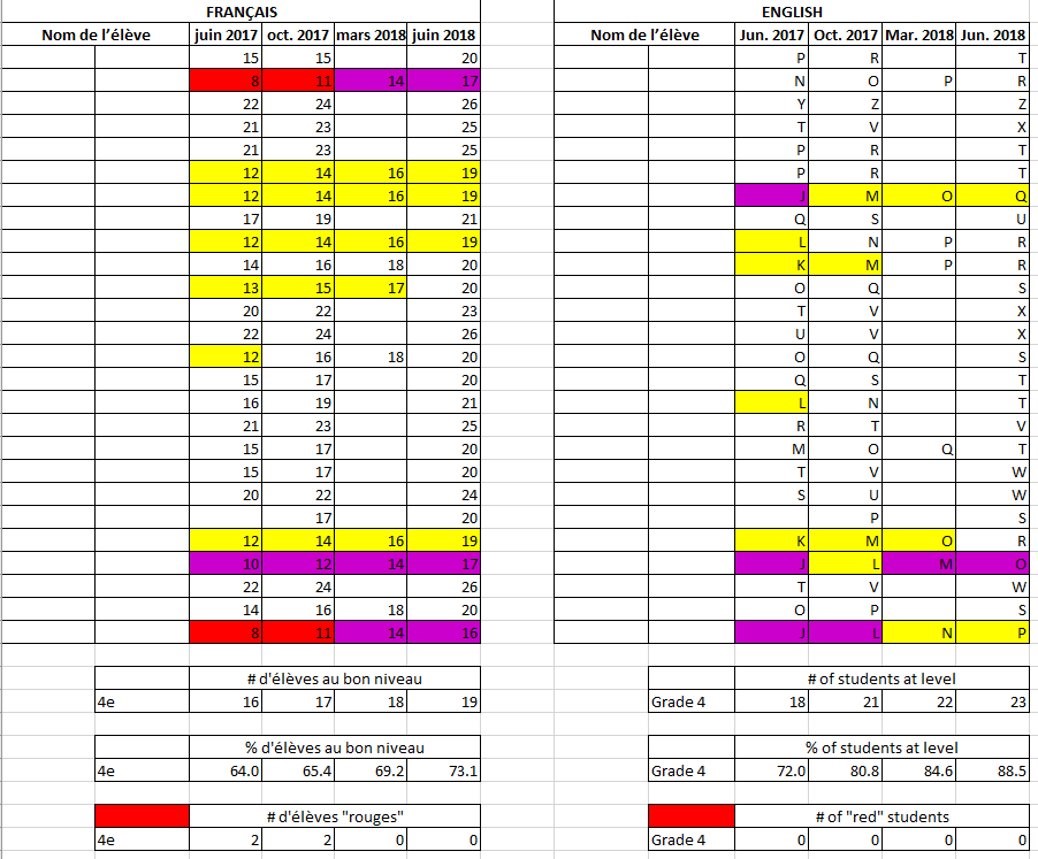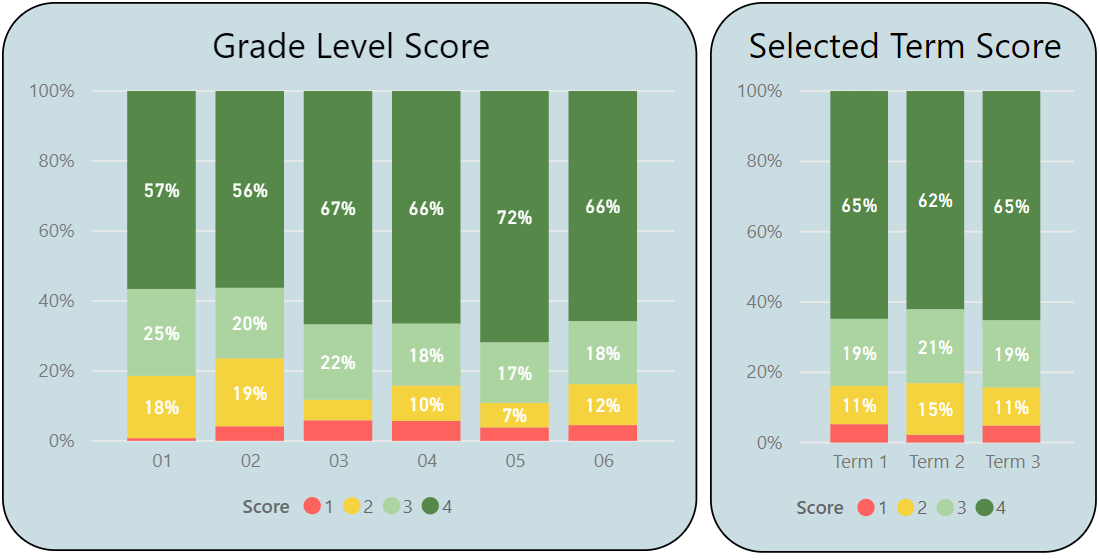Reading Interventions at École Howden
Reading Interventions at École Howden: A Seven-Year Journey
For the past seven years, teachers at École Howden have been exploring how we assess French reading and how we can incorporate the latest research when implementing reading interventions for our struggling readers.
Standardized measures were developed by our Student Services teachers and administration to be used across all grades by teachers to determine if interventions are needed:
- Provide training and support to teaching staff to ensure consistency in evaluation.
- Collect all running record data centrally.
- Define what is expected and what requires support.
- Use data to trigger specific interventions.
- Engage parents and students in goal setting.
- Set specific timelines to attain goals.
- Provide consistent support.
- Measure progress and communicate results.
- Set new goals as needed.
A response to intervention pyramid was then created for each grade. At the beginning of the school year, a literacy program which includes a structure and practice of reading as well as adaptations when needed, would be in place in every classroom. The data of all reading levels in French and in English reading for all our students was collected in October, March and June of the school year.

Interventions and Evaluations in Literacy:
Intervention in Kindergarten:
- Creating small groups based on the Phonological Awareness test results (PAST-R) to intervene in specific areas in English beginning in November. These interventions were developed by our literacy teacher (IPL) and Student Services teachers. Groups of up to four students for 15 minutes to focus on rhyming, syllable and sound activities for 2-6 depending on the intervention. If a student does not succeed following an intervention period, a second intervention period is set up later in the same school year to continue to work on the same concept.
Intervention in Grade 1:
- Continuation with small group interventions using the Phonological Awareness test results, focusing specifically on initial and final sound awareness and expression.
Intervention in Grade 2:
- IPL (Intervention Précoce en Lecture) is an early reading intervention program in French offered to students needing extra support. Numbers fluctuate between 5% and 30% of students requiring IPL support in Grade 2.
Interventions in Grade 3-6:
- Running record data analyzed by admin and SS to determine who is delayed by a year or more.
- Response to intervention pyramid kicks in with daily support at school, reinforcement at home and frequent evaluation in the context of a well-defined and timed goal.
- Use of running record data to guide intervention and instruction.
- Focus mostly on students who would be almost, but not quite delayed by a year in reading (2 on the report card in reading).
- Set targets, strategies and timelines for improvement.
- More evaluation for these students.
- Students with greater challenges have more long-term goals.
The following graphs show how our students from Grade 1 to 6 have performed in 2018-2019 (Graph: Grade Level Score) and how they performed by term (Graph: Selected Term Score):
- 4 (dark green): Very good to excellent understanding and application of concepts and skills
- 3 (light green): Good understanding and application of concepts and skills
- 2 (yellow): Basic understanding of application of concepts and skills
- 1 (limited understanding and application of concepts and skills

In the first year of implementing the response to intervention pyramid and specifying our evaluations by grade, the number of students delayed by a year or more in French reading decreased from 13% to 4% in 8 months. Extra targeted and timed practice made a difference for most learners, especially when parents are engaged.
However, there remained between 3-6% of students for most reporting periods in both English and French reading who continued to have a score of 1 (limited understanding).
So, what do we do with the 3-6% of students?
- Focus on the research that emphasizes a need for early identification and early intervention – as early as possible and before the student has sufficient vocabulary in a second language.
- Learn about the causes for the lack of progress.
- Students with learning disabilities – How are the brains of these students different than other students? How can we teach these students based on this knowledge?
"Implementing screening procedures which are conducted early on in Kindergarten, even if there is risk of over-identification, is seen as an effective, preventative model" (Vellutino et al. 2008). The following six variables not only correlated with later literacy as shown by data drawn from multiple studies with large numbers of children but also maintained their predictive power even when the role of other variables, such as IQ or socioeconomic status (SES), were accounted for:
- Alphabet knowledge
- Phonological awareness (Kindergarten)
- Rapid automatic naming (RAN) of letters or digits
- RAN of objects or colors
- Writing or writing name: the ability to write letters in isolation on request or to write one's own name (Kindergarten, Grade 1)
- Phonological memory
(National Institute of Literacy, 2008)
In 2018-2019, Student Services teachers, literacy teacher, our school psychologist and school administration developed the Grade 1 Pilot Project in French literacy. The first step was to collect lots of data to understand the learners in Kindergarten, specifically:
- Kindergarten Developmental Parent Questionnaire
- Alphabetic Principle
- PAST-R
- Attendance
- Kindergarten teacher observation data
- Fine motor skill analysis
- Phonological Awareness Intervention Data
Another important step was to create new data sources at the beginning of Grade 1 based on research:
- Random automatized naming test (colours)
- Recall memory test (numbers)
- Working memory test (numbers)
- Create cohort norms and retest students in English if they are below the norm.
Norms were created by comparing averages and medians:

Support will be focused on multi-sensory approaches. The following are some of the reactions from students to these approaches last year:
- It makes me write better. I'm learning the sounds better by practicing them more in many different ways.
- It makes it easier to learn. Words get into your head faster because we learned the rules for the sounds.
- We see the sounds more often and we do different activities that make us remember.
- Blending nonsense words has helped me put sounds together.
- The rules have helped me remember the sounds.
- Textured paper and sand is fun to touch.
- Reading in class is easier and less frustrating.
- It's going awesome for me! I learn better. I really like reading now. The rules totally make sense for me.
- It's easier because now I know the words.
- With the textured paper, I can feel the words move up my arm when I write.
- When I write on the textured paper, it looks like the shapes of the letters are coming out of the page.
- Repeat all evaluations for K-1 students
- Add fine motor evaluation
- Analyse all data with school psychologist, occupational therapist, speech and language pathologist, Student Services teachers, and IPL (literacy) teacher
- Collaboratively plan for each student
- Transition from Grade 2 IPL intervention to Grade 1 multi-sensory early literacy Intervention for all students
- IPL teacher to provide support for Grade 1 students as outlined in plans for students identified in screening as requiring support.
- Develop French resources
- Train all K-3 teachers in multisensory approaches to mimic the supports offered in literacy support and SS in all K-3 classrooms.
- Grade 1 teachers begin to integrate new strategies with literacy teacher interventions in classrooms.
- Develop French resources in collaboration with DSFM and other immersion schools.


.jpg)